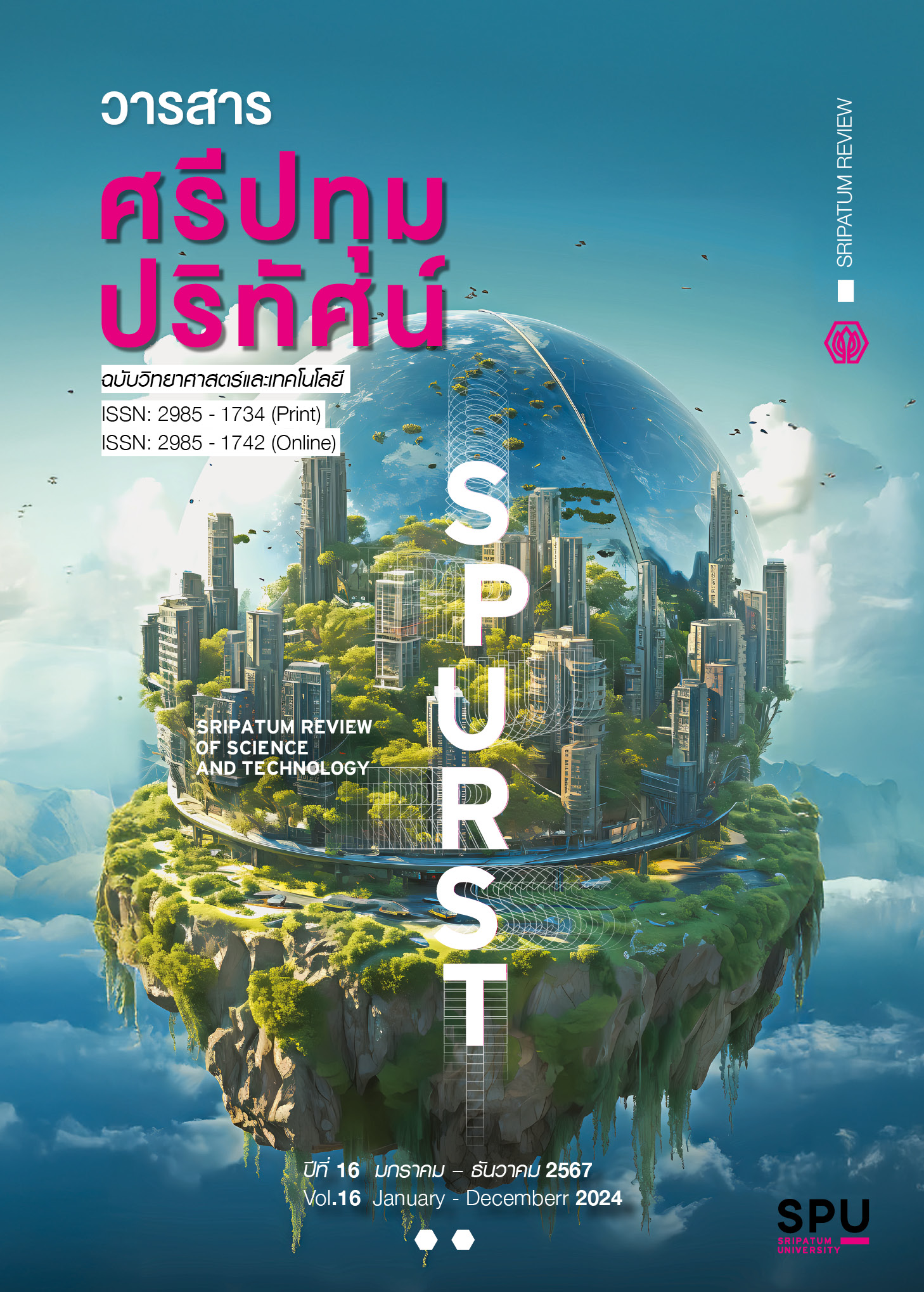Classification of Cactus Species Using Deep Learning Model
Main Article Content
Abstract
This research aims to develop a deep learning model for cactus species classification and evaluate its accuracy. Three popular deep learning models—ResNet34, VGG16 and MobileNetV3—are trained on a dataset of 4,512 images representing 10 cactus species that are popular among consumers, based on data from cactus shops in Mueang Nakhon Ratchasima district, Nakhon Ratchasima province. The dataset is augmented through various image transformations to increase its size and diversity, allowing the model to learn better and avoid overfitting. The training process includes hyperparameter tuning and the application of the one-cycle policy to adjust the learning rate and momentum for optimal weight adjustment using backpropagation. The evaluation results on the validation dataset show that MobileNetV3 achieves the highest accuracy of 91.36%, with precision, recall and f-measure values of 91.46%, 91.36%, and 91.20%, respectively. When tested on an unseen dataset of 400 images to assess the model's performance in real-world scenarios, the expert-verified cactus species classification accuracy reaches 81.50%
Article Details
References
Anderson, E. F. (2001). The cactus family. Portland, OR: Timber Press.
Barthlott, W., & Hunt, D. R. (1993). Cacti: An illustrated guide to the plants and their cultivation. Portland, OR: Timber Press.
Bay, H., Tuytelaars, T., & Van Gool, L. (2006). SURF: Speeded up robust features. The Proceedings of the European Conference on Computer Vision (ECCV), 7-13 May 2006, Graz, Austria, 404-417. https://doi.org/10.1007/11744023_32
Boser, B. E., Guyon, I. M., & Vapnik, V. N. (1992). A training algorithm for optimal margin classifiers. The Proceedings of the Fifth Annual Workshop on Computational Learning Theory, 27-29 July 1992, Pittsburgh, PA, USA, 144-152. https://doi.org/10.1145/130385.130401
Breiman, L. (2001). Random forests. Machine Learning, 45(1), 5-32. https://doi.org/10.1023/A: 1010933404324
Dalal, N., & Triggs, B. (2005). Histograms of oriented gradients for human detection. The Proceedings of the IEEE Conference on Computer Vision and Pattern Recognition (CVPR), 20-25 June 2005, San Diego, CA, USA, 886-893. https://doi.org/10.1109/CVPR.2005.177
He, K., Zhang, X., Ren, S., & Sun, J. (2016). Deep residual learning for image recognition. The Proceedings of the IEEE Conference on Computer Vision and Pattern Recognition (CVPR), 27-30 June 2016, Las Vegas, NV, USA, 770-778. https://doi.org/10.1109/CVPR.2016.90
Hongboonmee, N., & Thamditae, A. (2023). Preliminary classification of gemstones via mobile application using deep learning processes. Sripatum Review of Science and Technology, 15, 71-85. (in Thai)
Howard, A., Sandler, M., Chu, G., Chen, L. C., Chen, B., & Tan, M. (2019). Searching for MobileNetV3. The Proceedings of the IEEE/CVF International Conference on Computer Vision (ICCV), 27 Oct-2 Nov 2019, Seoul, South Korea, 1314-1324. https://doi.org/10.1109/ICCV.2019.00139
Hunt, D., Taylor, N., & Charles, G. (2006). The new cactus lexicon. Milborne Port, UK: DH Books.
Kamilaris, A., & Prenafeta-Boldú, F. X. (2018). Deep learning in agriculture: A survey. Computers and Electronics in Agriculture, 147, 70-90. https://doi.org/10.1016/j.compag.2018.02.016
Kingma, D. P., & Ba, J. (2014). Adam: A method for stochastic optimization. [Online]. Retrieved from: https://arXiv preprint arXiv: 1412.6980.
LeCun, Y., Bengio, Y., & Hinton, G. (2015). Deep learning. Nature, 521(7553), 436-444. https://doi.org/10.1038/nature14539
Lowe, D. G. (1999). Object recognition from local scale-invariant features. The Proceedings of the IEEE International Conference on Computer Vision (ICCV), 20-27 September 1999, Corfu, Greece, 1150-1157. https://doi.org/10.1109/ICCV.1999.790410
Perez, L. & Wang, J. (2017). The effectiveness of data augmentation in image classification using deep learning. [Online]. Retrieved from: https://arXiv preprint arXiv:1712.04621.
Powers, D. M. (2011). Evaluation: From precision recall and F-measure to ROC informedness markedness and correlation. Journal of Machine Learning Technologies, 2(1), 37-63.
Ruder, S. (2016). An overview of gradient descent optimization algorithms. [Online]. Retrieved from: https://arXiv preprint arXiv: 1609.04747.
Rumelhart, D. E., Hinton, G. E., & Williams, R. J. (1986). Learning representations by back-propagating errors. Nature, 323(6088), 533-536. https://doi.org/10.1038/323533a0
Sae-Lim, W., Wettayaprasit, W., & Aiyarak, P. (2019). Convolutional Neural Networks Using MobileNet for Skin Lesion Classification. The Proceedings of 16th International Joint Conference on Computer Science and Software Engineering (JCSSE), 10-12 July 2019 at Chonburi, Thailand, 242-247.
Sangsuriyong, R. (2022). The risks of measurement error in quantitative research in sociology. Journal of Humanities and Social Sciences, Burapha University, 30(1), 158-185. (in Thai)
Sivic, J., & Zisserman, A. (2003). Video Google: A text retrieval approach to object matching in videos. The Proceedings of the IEEE International Conference on Computer Vision (ICCV), 13-16 October 2003, Nice, France, 1470-1477. https://doi.org/10.1109/ICCV.2003.1238663
Shmida, A. & Burgess, T. L. (1988). Plant growth form strategies and vegetation processes in the deserts of Israel and the Sinai. Plant Species Biology, 3(1), 59-69.
Shorten, C., & Khoshgoftaar, T. M. (2019). A survey on image data augmentation for deep learning. Journal of Big Data, 6(1), 1-48. https://doi.org/10.1186/s40537-019-0197-0
Simonyan, K. & Zisserman, A. (2014). Very deep convolutional networks for large-scale image recognition. [Online]. Retrieved from: https://arXiv preprint arXiv:1409.1556.
Smith, L. N. (2018). A disciplined approach to neural network hyper-parameters: Part 1 - Learning rate, batch size, momentum, and weight decay. [Online]. Retrieved from: https://arXiv preprint arXiv:1803.09820.
Sokolova, M., & Lapalme, G. (2009). A systematic analysis of performance measures for classification tasks. Information Processing & Management, 45(4), 427-437.
Srisaat, B. (2013). Introduction to research. 9th ed. Bangkok: Suweiryasarn.
Yosinski, J., Kirsch, A., Ramsey, J., Schneider, J., & Soh, M. (2014). How transferable are features in deep neural networks? [Online]. Retrieved from: https://arxiv.org/abs/1411.1792
Zhu, F., Sun, Y., Zhang, Y., Zhang, W., & Qi, J. (2023). An Improved MobileNetV3 Mushroom Quality Classification Model Using Images with Complex Backgrounds. Agronomy, 13(12), 2924. https://doi.org/10.3390/agronomy13122924.


